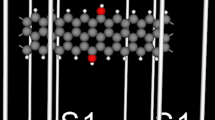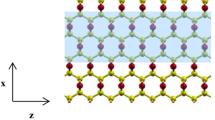Abstract
The effect of oxygen (O) doping in Zigzag graphene nanoribbons (GNR) has been investigated in terms of their stability and electronic properties, using a density-functional theory-based ab-initio approach. The Zigzag GNR has been subjected to mono vacancy, and decorated with three possible sites of oxygen impurities around the monovacancy (MV). The stability of the systems has been analyzed in terms of cohesive energy and the electronic properties in terms of band structure and density of states profiles. The cohesive energy calculations suggest that the formation of the pyridine-type defects with oxygen doping has nearly the same stability as in case of monovacancy introduced system. From the electronic band structure and density of state profile, it has been observed that the metallicity of the ZGNR enhances with O doping, which can further be validated through the increase in density of states at the Fermi level, as well as the electron density and electron difference density profiles. This enhanced metallicity in ZGNR defends its possible application as metallic electrodes and interconnects in the electronic industry.
Graphic abstract

Geometry, bandstructure, density of states and electron difference density of oxygen decorated MVZGNR.





Similar content being viewed by others
Data availability
The datasets generated during and/or analysed during the current study are available from the corresponding author on reasonable request.
References
A.H. Castro Neto, F. Guinea, N.M.R. Peres, K.S. Novoselov, A.K. Geim, Rev. Mod. Phys. 81, 109–162 (2009)
K.S. Novoselov, A.K. Geim, S.V. Morozov, D. Jiang, Y. Zhang, S.V. Dubonos, I.V. Grigorieva, A.A. Firsov, Science (-80) 306, 666–669 (2004)
A.K. Geim and K.S. Novoselov, in: Nanosci. Technol. A Collect. Rev. from Nat. Journals, World Scientific, (2010), pp. 11–19.
Y. Xu, A. Srivastava, Int. J. Circuit Theory Appl. 38, 559–575 (2010)
B.K. Kaushik and M.K. Majumder, in: Carbon Nanotub. Based VLSI Interconnects, Springer, (2015), pp. 17–37.
M.V. Kharlamova, Prog. Mater. Sci. 77, 125–211 (2016)
S. Rakheja, V. Kumar, A. Naeemi, Proc. IEEE 101, 1740–1765 (2013)
P. Sharma, I. Kaur, S. Gupta, S. Singh, in AIP Conference Proceedings (AIP Publishing LLC, 2016), p. 20110
S. Singh, A. De Sarkar, I. Kaur, Mater. Res. Bull. 87, 167–176 (2017)
P. Rani, V.K. Jindal, RSC Adv. 3, 802–812 (2013)
J.C. Meyer, C. Kisielowski, R. Erni, M.D. Rossell, M.F. Crommie, A. Zettl, Nano Lett., 8, 3582–3586 (2008)
A. Hashimoto, K. Suenaga, A. Gloter, K. Urita, S. Iijima, Nature 430, 870–873 (2004)
A.W. Robertson, B. Montanari, K. He, C.S. Allen, Y.A. Wu, N.M. Harrison, A.I. Kirkland, J.H. Warner, ACS Nano 7(5), 4495–502 (2013)
M.K. Kostov, E.E. Santiso, A.M. George, K.E. Gubbins, M.B. Nardelli, Phys. Rev. Lett., 95, 136105 (2005)
J. Feng, Y.-J. Liu, J. Zhao, J. Mol. Model., 20, 1–7 (2014)
Z. Hou, D.-J. Shu, G.-L. Chai, T. Ikeda, K. Terakura, J. Phys. Chem. C, 118, 19795–19805 (2014)
J.M. Chem, T.P. Kaloni, Y.C. Cheng, R. Faccio, U. Schwingenschl, J. Mater. Chem. 21(45), 18284–18288 (2011)
https://www.synopsys.com/silicon/quantumatk.html. Accessed 10 Dec 2020
S. Agrawal, A. Srivastava, G. Kaushal, in 2020 IEEE 10th International Conference Nanomaterials: Applications & Properties (2020), pp. 01TPNS03-1–01TPNS03-5
Y. Fujimoto, S. Saito, Phys. Rev. B 84, 1–7 (2011)
A.G. Garcia, S.E. Baltazar, A.H.R. Castro, J.F.P. Robles, A. Rubio, J. Comput. Theor. Nanosci. 5, 2221–2229 (2008)
Author information
Authors and Affiliations
Corresponding author
Ethics declarations
Conflict of interest
The authors declare that they have no known competing financial interests or personal relationships that could have appeared to influence the work reported in this paper.
Rights and permissions
About this article
Cite this article
Agrawal, S., Kaushal, G. & Srivastava, A. Enhanced metallicity in defected Zigzag graphene nanoribbons: Role of oxygen doping. MRS Advances 6, 723–728 (2021). https://doi.org/10.1557/s43580-021-00121-1
Received:
Accepted:
Published:
Issue Date:
DOI: https://doi.org/10.1557/s43580-021-00121-1




